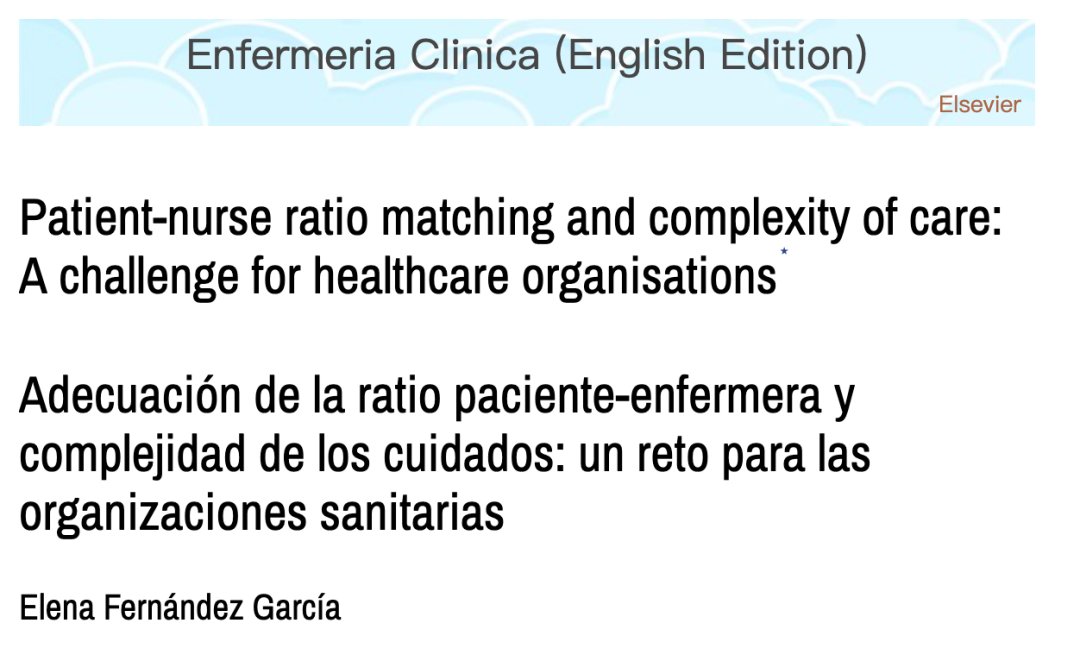护患比|护患比和护理复杂性:医疗机构面临的挑战

文章插图

文章插图
分享智慧
共同成长

文章插图
Full text
The current COVID-19 pandemic has shed further light on the needs and complexity of care faced by today’s healthcare organisations, globally and in the Spanish context. Care complexity has been included in the analysis of institutional outcomes as an indicator that has interrelated and interdependent elements. At the hospital level, the key components of care complexity are the healthcare organisation itself, nurses, and the care dependency of patients.1
In relation to the first two components of complexity, organisational factors influence healthcare quality, particularly in relation to the work climate and job satisfaction of healthcare professionals.2 Moreover, ensuring the provision of objective quality care based on outcomes that are sensitive to nursing practice, i.e., that can be assessed with a set of specific, defined indicators, remains a major challenge today.3
In relation to the third component, the care dependency of the population, we are facing an ageing society, with increased life expectancy that will lead to the progression of both acute and chronic diseases. This situation will result in an increase in the number of the most care-dependent people admitted to hospitals in the near future.4
In this context, the scientific evidence shows that work overload in nurses leads to an increase in in-hospital adverse events and mortality. A key indicator, therefore, is the patient-to-nurse ratio per hospital, known in the English language literature as Nursing Staffing Level (NSL), defined as the number of nurses working per shift or more than 24 h divided by the number of beds occupied by a patient during the same period. However, although many studies have used this system to assess ratios in hospital settings because it is easy and inexpensive, it has certain limitations; for example, it does not consider status and level of dependency in patient care.5
To date, determining the optimal patient-nurse ratio in hospitals remains a challenge for the scientific community.6 Among others, the paper by Dr Aiken is of note. It examines nurse staffing levels in hospitals and their relationship with adverse events such as mortality. In her research she notes that for every patient added to the workload of a nurse in a surgical unit, the likelihood of patient survival is reduced by 5% during their hospital stay.7 Furthermore, lack of vigilance can lead to adverse events (AE) and a deterioration in the condition of patients, which could be avoided, thus reducing risk, and maximising clinical safety. Adequate staffing levels, therefore, have a positive impact on the healthcare system, and are related to a reduction in morbidity and mortality, and costs.8
Some of the AEs that occur in the hospital setting are directly related to complications during hospital stay, increasing the length of stay and even leading to death. According to the ‘Spanish National Study on Adverse Events linked to Hospitalisation’, the overall incidence of adverse events was estimated at 11.6% and mortality because of these events at 4.4%.9
In-hospital mortality is commonly used as an indicator to assess the quality of hospital care as it can be easily calculated from the data recorded in the databases of the different hospitals. In fact, when there is a high mortality rate in a centre, it is considered a marker that reflects poor care. Therefore, in hospitals where around 50% of deaths occur in one area, an increase in deaths of around 10% could be due to a lack of effective and safe care.10
Therefore, it is essential that we address care complexity by analysing all its components to identify the variables that influence and thus improve healthcare. The profile of the patient admitted to conventional medical wards in regional hospitals, is an average of 76-years old or more and educated to primary level.11 This situation is worrying when it is predicted that by the year 2050 Spain will have one of the most ageing populations in the world, with an increase from 16% to 34% over 65 years of age.2
推荐阅读
- 上海对外经贸大学|工作十年后,才发现老师和公务员竟有这么大的差距,你选对了吗?
- 基础教育|又一“铁饭碗”招聘,工作稳定福利好,有望拿50万安家费和补贴
- 考生|报考普通话水平等级测试比春运抢票还难?
- 距离感|声音对学习有多重要?能提升专注力和模仿准确度!
- 学生|考研招28人,却让319人进入复试,为何要有这么高的差额比?
- 毕业生|新一线和二线城市吸引力增强 大学生就业有哪些新动向?
- 大学|大学哪些专业对身高要求?这6类差1cm也报不上,家长和学生要清楚
- 维修|把专业和课堂建在“产业链”上
- 合理安排|注意!寒假大、中、小学生和幼儿健康生活提示要诀来了
- 书目|阅读变现











